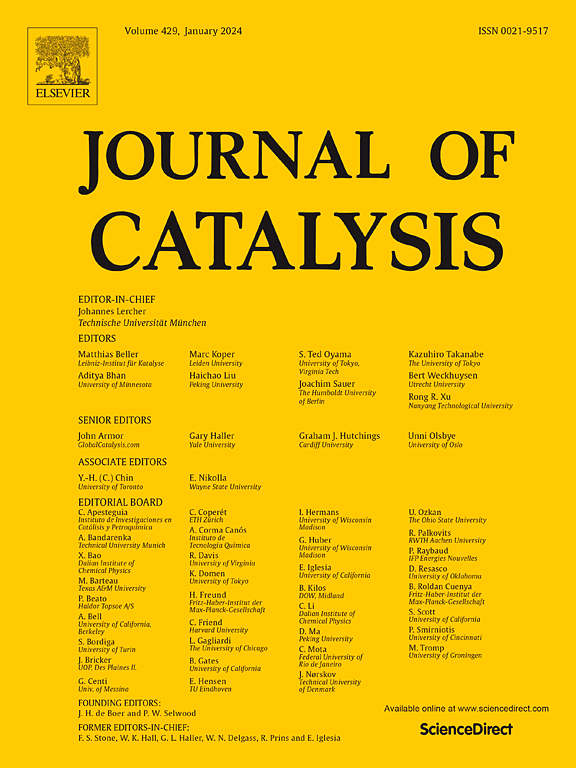Engineering amorphous MoS2/RGO hybrid nanoflowers with rich edge sites boost catalytic hydrogen generation
IF 6.5
1区 化学
Q2 CHEMISTRY, PHYSICAL
引用次数: 0
Abstract
To date, the electrolytic water splitting continues to be hindered by its high overpotential and sluggish kinetics of hydrogen evolution reaction (HER). Here, we design a new amorphous MoS2/reduced graphene oxide hybrid nanoflowers (A-MoS2/RGO NFs) architecture, in which two-dimensional (2D) few-layer MoS2 nanosheets are grown on RGO, and assemble into three-dimensional (3D) nanoflowers. The amorphous MoS2/RGO hybrid nanoflowers have plenty of exposed edge sites, which have been proved to be the catalytic active sites for HER. Besides, the distinctive and robust 3D architecture of amorphous MoS2/RGO hybrid nanoflowers facilitate the HER by enhancing both mass transport and charge transfer kinetics. The amorphous MoS2/RGO hybrid nanoflowers exhibit extraordinary HER performance with almost zero onset overpotential, small Tafel slope and extreme high electrochemical durability in wide pH range. The density functional theory (DFT) calculations demonstrate that the charge transfer from RGO to amorphous MoS2, which increase the charge density of the edge-terminated Mo and S atoms. This unique electronic configuration facilitates efficient H2O activation and dissociation, the subsequent H* adsorption and conversion processes, thereby significantly enhancing HER performance.


具有丰富边缘位点的工程无定形MoS2/RGO杂化纳米花促进催化制氢
迄今为止,电解水裂解仍然受到其高过电位和析氢反应(HER)动力学缓慢的阻碍。在这里,我们设计了一种新的非晶MoS2/RGO混合纳米花(a -MoS2/RGO NFs)结构,其中二维(2D)少层MoS2纳米片生长在还原氧化石墨烯(RGO)上,并组装成三维(3D)纳米花。无定形MoS2/RGO杂化纳米花具有大量的边缘暴露位点,这些边缘暴露位点已被证明是HER的催化活性位点。此外,非晶态MoS2/RGO杂化纳米花独特且坚固的三维结构通过增强质量传递和电荷传递动力学来促进HER。无定形MoS2/RGO杂化纳米花表现出优异的HER性能,几乎为零过电位,塔非斜率小,在宽pH范围内具有极高的电化学耐久性。密度泛函理论(DFT)计算表明,电荷从还原氧化石墨烯转移到无定形MoS2,从而增加了边缘Mo和S原子的电荷密度。这种独特的电子结构促进了高效的H2O活化和解离,随后的H*吸附和转化过程,从而显著提高了HER性能。
本文章由计算机程序翻译,如有差异,请以英文原文为准。
求助全文
约1分钟内获得全文
求助全文
来源期刊

Journal of Catalysis
工程技术-工程:化工
CiteScore
12.30
自引率
5.50%
发文量
447
审稿时长
31 days
期刊介绍:
The Journal of Catalysis publishes scholarly articles on both heterogeneous and homogeneous catalysis, covering a wide range of chemical transformations. These include various types of catalysis, such as those mediated by photons, plasmons, and electrons. The focus of the studies is to understand the relationship between catalytic function and the underlying chemical properties of surfaces and metal complexes.
The articles in the journal offer innovative concepts and explore the synthesis and kinetics of inorganic solids and homogeneous complexes. Furthermore, they discuss spectroscopic techniques for characterizing catalysts, investigate the interaction of probes and reacting species with catalysts, and employ theoretical methods.
The research presented in the journal should have direct relevance to the field of catalytic processes, addressing either fundamental aspects or applications of catalysis.
 求助内容:
求助内容: 应助结果提醒方式:
应助结果提醒方式:


